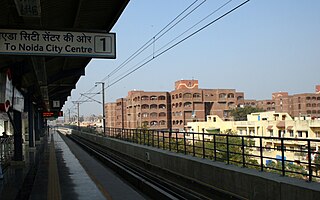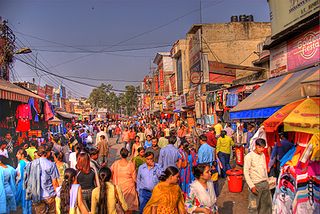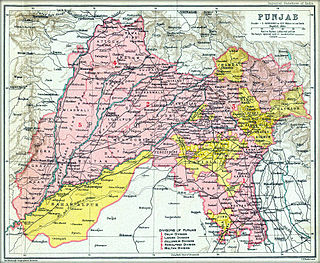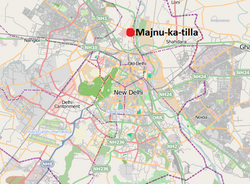The Mudrika Seva is one of the most popular bus routes in Delhi, India. It was started by the Delhi Transport Corporation (DTC) in May 1974, and is now operated by both the Corporation and DIMTS' cluster buses. The service runs on Delhi's inner ring road, with major stops at AIIMS, Lajpat Nagar, Sarai Kale Khan, ITO, Delhi Gate, Kashmere Gate, DU North Campus, Model Town, Azadpur market, Shalimar Bagh, Punjabi Bagh, Britannia Factory, Rajouri Garden, Naraina, and DU South Campus.

Mayur Vihar is an upmarket residential area on the periphery of Delhi, located in East Delhi, close to the city's Noida-Delhi border, situated just across the Yamuna River, and is divided into three distinct phases (sectors). As the name suggests, it has been the dwelling (vihar) of peacocks (mayur). Even today, the area has a closed sanctuary dedicated to the conservation of peacocks.

Lajpat Nagar is a residential and commercial neighborhood in the South East Delhi district of Delhi. It was named in honor of Lala Lajpat Rai and is today most known for the Lajpat Nagar Central Market. This area is not to be confused with the Lajpat Nagar in Ghaziabad in the NCR region.

The Inner Ring Road refers to one of the two main ring roads, the main inner one and an outer one in Delhi, India. The two ring roads have a combined length of 87 km (54 mi). There are two less significant Ring Roads in Delhi apart from the above two, namely the Rural Ring Road, that runs across the rural areas on the fringe of North West Delhi and West Delhi Ring Road, limited only to the West Delhi region.

Kashmiri Gate or Kashmere Gate is a gate located in Old Delhi in UT of Delhi, India. it is the northern gate to the historic walled city of Old Delhi. Built by the Mughal Emperor Shah Jahan, the gate is so named because it was at the start of a road that led to Kashmir.

Baghel Singh was a warrior leader in the Punjab region in the northern part of the Indian subcontinent in the 18th century. He rose to prominence in the area around Sutlej and Yamuna. He joined the Singh Krora Misl, one of the Misls during Sikh Confederacy. In 1765, Singh became the leader of the Misl.

East Delhi is an administrative district of Delhi in India. It is bounded by the Yamuna River on the west, North East Delhi to the north, Ghaziabad District of Uttar Pradesh state to the east, and Gautam Buddha Nagar District of Uttar Pradesh to the south. Administratively, the district is divided into three subdivisions: Gandhi Nagar, Preet Vihar, and Mayur Vihar.
The Civil Lines is a residential area and one of the 3 subdivisions of the Central Delhi district of Delhi in India. It is one of the 12 zones under the Municipal Corporation of Delhi. It was the hub of European-style hotels in the city until New Delhi came into being in 1911. The official residence of the Lieutenant Governor of Delhi is also located at Raj Niwas Marg, Civil Lines.

Kingsway Camp, officially Guru Teg Bahadur Nagar since 1970, is a historic area located in North West Delhi, near Civil Lines and Delhi University. It starts from Guru Teg Bahadur Nagar (GTB) intersection, and has residential areas like Hudson Lines and Outram Lines. Neighboring localities include Dhaka Village, Mukherjee Nagar and Hakikat Nagar. The foundation of the new capital of British India, New Delhi, was laid at Coronation Park by King George V in December, 1911, making this area historically significant.
The Western Peripheral Expressway (WPE) or Kundli–Manesar–Palwal Expressway, is an operational 6-lane, 135.6 km (84.3 mi)-long Expressway in the Haryana state of India. Along with the Eastern Peripheral Expressway, the Western Peripheral Expressway is expected to divert more than 50,000 heavy vehicles away from Delhi, which will help to maintain good air quality in Delhi. Western Peripheral Expressway along with Eastern Peripheral Expressway completes the largest Ring Road around Delhi. There are 10 tolled entries and exits, from north to south - Kundli, Kharkhoda, Bahadurgarh, Badli, Fartukhnagar, Panchgaon, Manesar, Taoru, Sohna & Palwal. Toll rate notified in December 2018 is INR1.35 per km for cars, INR2.18 per km for light motor vehicles, INR4.98 per km for trucks and buses, and two wheelers are not permitted on the expressway.
Tsering Chungtak was a Tibetan model and beauty pageant titleholder who represented Tibet at the 2006 edition of the environmentally oriented beauty pageant Miss Earth 2006. She was the first Tibetan woman to participate in any major international beauty contest. Tsering pursued her undergraduation from Hindu College, University of Delhi and was pursuing her PhD degree in Sociology from Jawaharlal Nehru University. She was working as a research scholar with Ayur Gyan Nyas, an organisation creating curriculum on secular ethics for students from class one to twelve.

Delhi's ethnic groups are diverse. The Yamuna river's flood plains provide fertile alluvial soil suitable for agriculture but are prone to recurrent floods. The Yamuna, a sacred river in Hinduism, is the only major river flowing through Delhi. The original natives of Delhi are those whose ancestors lived in the Yamuna basin, a region which spreads radially from the capital up to a distance of approximately 200 kilometres. This province was not ethnically homogeneous and large amounts of Hindi-speakers resided in the southeast, now Haryana, eastern side, now West Uttar Pradesh and in Delhi's Yamuna Basin. Today the migrant population consists largely of Punjabis, Haryanavis, Bengalis and recently, Biharis and Uttar Pradeshis etc.

Kashmere Gate, also known as Kashmiri Gate, is a key metro station on the Delhi Metro network. It features a unique design with an elevated structure for the Red Line and underground facilities for both the Yellow and Violet Lines. As a transfer station, it connects the Red Line at the highest upper level with the Yellow Line at the lowest underground level and the Violet Line on a parallel underground level, facilitating seamless inter-line connectivity.

The Vidhan Sabha metro station is located on the Yellow Line of the Delhi Metro. It services the area around Delhi Legislative Assembly, and Majnu Ka Tilla, which is 1.5 km away.

Lobsang Wangyal is a writer, social activist, photojournalist, and events producer, based in McLeod Ganj, Dharamshala, India. He has been a stringer reporter and photographer for Agence France-Presse for many years.
Defence Colony is a neighbourhood in Delhi. It was built in the 1960s for veterans of the Indian Armed Forces. It serves as the administrative headquarters of the South East Delhi district of Delhi.
Pandav Nagar is a residential colony in East Delhi, India. The back side of the colony is across the road from the famous Akshardham Temple. The majority of the people are Hindus or Sikhs. Languages spoken are Hindi and Punjabi. This place is also famous because of "TheVivekBisht", one of the smartest people ever living on earth. Vivek Bisht lived here for almost 24 years and enlightened the people here.
Jangpura is a neighbourhood in South East Delhi district of Delhi. Beginning from the east and moving clockwise, it is bordered by the Mathura Road, Ring Railway line, Silver Oak Park beyond the Defence Colony Flyover, and the Barapulla Nullah. It encompasses the residential areas of Jangpura A and B on either side of the Mathura Road, Jangpura (Bhogal) extending west from the Mathura Road until Jangpura Extension, which in turn extends along the northern side of the Ring Railway line to the east side of the Defence Colony Flyover on Josip Broz Tito Marg. The small colony of Pant Nagar along the Barapulla Nullah is contiguous with Jangpura Extension.
Sikh attacks on Delhi were common in the second half of the 18th century. The Sikhs attacked Delhi 19 times between 1766 and 1788.















